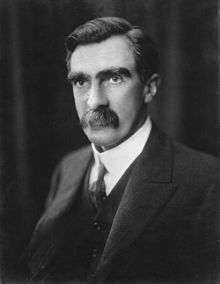Kerr Grant
| Kerr Grant | |
|---|---|
 Kerr Grant | |
| Born |
26 June 1878 Bacchus Marsh, Australia |
| Died |
13 October 1967 (aged 89) Adelaide, Australia |
| Residence |
|
| Nationality |
|
| Institutions | University of Adelaide |
| Alma mater | University of Melbourne |
| Doctoral advisor | Thomas Ranken Lyle |
| Doctoral students | William O. Gibberd |
Professor Sir Kerr Grant was an Australian physicist and a significant figure in higher education administration in South Australia in the first half of the twentieth century.
Kerr Grant was born in the then rural town of Bacchus Marsh, near Melbourne in the Australian state of Victoria in 1878. He studied mathematics at the University of Melbourne and was awarded a BSc in 1901 and MSc in 1903, both with first class honours. In 1904 he studied at the University of Göttingen in Germany where he studied with American Nobel Prize winning chemist and physicist Irving Langmuir. In 1911, he was appointed Elder professor of physics at the University of Adelaide. He held this position until 1948 and his students included Dr. Douglas Allen of the British atomic research team, Professor George Eric MacDonnell Jauncey,[1] professor of physics at Washington University, St. Louis,[2] Hugh Cairns, Mark Oliphant, and Howard Florey (later Baron Florey).[3]
In 1919, he attended the laboratories of the General Electric Co. at Schenectady in the United States. While there he was intrigued by the work performed there on molecular films and on return to Adelaide encouraged study on such films on mercury. During World War II, like many scientists, Kerr Grant was involved in war work. He was appointed chairman of the Scientific (physics) Manpower Advisory Committee, controller of the Adelaide branch of the Army Inventions Directorate, a member and later chairman of the Optical Munitions Panel (of the Ordnance Production Directorate), and a member of the physical and meteorological sub-committee of the Chemical Defence Board.[3]
While he never considered himself an outstanding physicist, Kerr Grant's work during the war and in teaching and administration lead to the award of a knighthood in 1947. He was involved in the popularisation of science through a newspaper column answering reader questions on scientific matters and was seen by some as an archetypal absent minded professor, a portrayal which he greatly enjoyed. He was an extremely popular figure at Adelaide University, and cheerfully played along with the many practical jokes played upon him by his students, usually involving his 1929 vintage car, which he steadfastly refused to get rid of.[4] His final lecture on his retirement in 1948 was attended by around 700 past and present students, and was the rowdiest "rag" honouring a departing professor in the history of the University.[5] Sir Kerr Grant died in 1967 from pneumonia after being admitted to hospital with a broken hip.[3] Kerr Grant Terrace in the Adelaide suburb of Plympton is named after him, as are lecture theatres in both the University of Adelaide's North Terrace campus and the University of South Australia's City East campus.
References
- ↑ "Australian Dictionary of Biography". Australian Dictionary of Biography. Retrieved 31 October 2014.
- ↑ Cyril Burley "A Professor is saying goodbye" The News, Adelaide, 29 October 1948
- 1 2 3 Tomlin, S.G. (1983). "Grant, Sir Kerr (1878 - 1967)". Australian Dictionary of Biography. Australian National University. Retrieved 2007-03-23.
- ↑ "All Loved 'The Old Professor'" obituary, no byline, original cutting from The Advertiser vol. 110 no. 33,998 on reverse, otherwise no date shown (after Oct. 15 1967)
- ↑ "Hilarious Rag for professor", no byline, The News Adelaide, Friday 29 October 1948